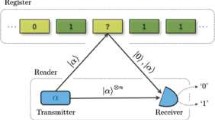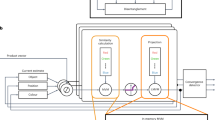Abstract
A holographic experimental procedure assuming use of quantum states of light is simulated. It uses merely interference-based image storage and nonunitary image retrieval realized by wave function collapse. Successful results of computational view-invariant recognition of object images are presented. As in neural net theory, recognition is selective reconstruction of an image from a database of many concrete images (simultaneously stored in an associative memory) after presentation of a different version of that image. That is, in the first step, we store many high-resolution images of objects into quantum memory (a hologram). In the second step, we present a “nonlearned” noisy image version. We thereby trigger memory-influenced reorganization of the state of the system so that it finally encodes those corrected object images that correspond to the newly presented version. The holographic procedure seems to be implementable with present-day quantum optics.
Similar content being viewed by others
References
D. Bouwmeester, A. Ekert, and A. Zeilinger, The Physics of Quantum Information (Springer, Berlin, 2000).
M. Andrecut and M. K. Ali, Int. J. Mod. Phys. B 17, 2447 (2003).
C. Trugenberger, Phys. Rev. Lett. 87, 067901 (2001).
C. Trugenberger, Phys. Rev. Lett. 89, 277903 (2002).
D. Ventura and T. Martinez, Inf. Sci. (N.Y.) 124, 273 (2000).
J. Howell, J. Yeazell, and D. Ventura, Phys. Rev. A 62, 042303 (2000).
R. Schützhold, quant-ph/0208063; M. Sasaki et al., Phys. Rev. A 64, 022 317 (2001).
M. Peruš and S. Dey, Appl. Math. Lett. 13(8), 31 (2000).
R. Spencer, IEEE Trans. Neural Netw. 12, 463 (2001).
J. Sutherland, Int. J. Neural Syst. 1, 256 (1990).
I. Averbukh, M. Shapiro, C. Leichtle, and W. Schleich, Phys. Rev. A 59, 2163 (1999); P. Len et al., J. Electron Spectrosc. 85, 145 (1997); N. Bhattacharya et al., Phys. Rev. Lett. 88, 137901 (2002).
A. Leonardis and H. Bischof, Comput. Vis. Image Underst. 78, 99 (2000).
H. Bjelkhagen and H. J. Caulfield, Selected Papers on the Fundamental Techniques in Holography (SPIE Opt. Eng. Press, Bellingham, 2001).
F. T. S. Yu and S. Jutamulia, Optical Pattern Recognition (Cambridge Univ. Press, Cambridge, 1998).
M. Peruš and H. Bischof, in Proceedings of the 7th Joint Conference on Information Sciences, Ed. by K. Chen et al. (JCIS/Association Intell. Mach., Durham, NC, 2003), pp. 1536–1539; quant-ph/0303092.
T. C. Weinacht, J. Ahn, and P. H. Baucksbaum, Nature 397, 233 (1999).
W. Schleich, Quantum Optics in Phase Space (Wiley-VCH, Berlin, 2001).
A. Granik and H. J. Caulfield, in Holography (SPIE Opt. Eng. Press, Bellingham, WA, 1990), Vol. IS 8, pp. 33–38.
M. Peruš, Neural Netw. World 10, 1001 (2000).
A. V. Pavlov, Opt. Spektrosk. 90, 515 (2001) [Opt. Spectrosc. 90, 452 (2001)].
B. C. Travaglione and G. J. Milburn, Phys. Rev. A 63, 032301 (2001); J. L. Krause et al., Phys. Rev. Lett. 79, 4978 (1997).
X. Chen and J. Yeazell, Phys. Rev. A 56, 2316 (1997).
D. Goswami, Phys. Rep. 376, 385 (2003).
D. T. Smithey et al., Phys. Rev. Lett. 70, 1244 (1993).
M. Peruš, H. Bischof, and C. K. Loo, quant-ph/0401016.
M. Peruš, Int. J. Computing Anticip. Sys. 13, 376 (2002).
S. Haykin, Neural Networks (MacMillan, New York, 1994).
L. Personnaz, I. Gliyon, and G. Dreyfus, Phys. Rev. A 34, 4217 (1986).
I. Kanter and H. Sompolinsky, Phys. Rev. A 35, 380 (1987).
G. Rigatos and S. Tzafestas, in Proceedings of the 7th Joint Conference on Information Sciences, Ed. by K. Chen et al. (JCIS/Association Intell. Mach., Durham, NC, 2003), p. 1532.
T. Lee, IEEE Trans. Pattern. Anal. Mach. Intell. 18(10), 1 (1996); R. Young, Wavelet Theory and Its Applications (Kluwer, Boston, 1993).
Author information
Authors and Affiliations
Additional information
From Optika i Spektroskopiya, Vol. 99, No. 2, 2005, pp. 233–238.
Original English Text Copyright © 2005 by Chu Kiong Loo, Peruš, Bischof.
The text was submitted by the authors in English.
Rights and permissions
About this article
Cite this article
Loo, C.K., Peruš, M. & Bischof, H. Simulated quantum-optical object recognition from high-resolution images. Opt. Spectrosc. 99, 218–223 (2005). https://doi.org/10.1134/1.2034607
Received:
Issue Date:
DOI: https://doi.org/10.1134/1.2034607




